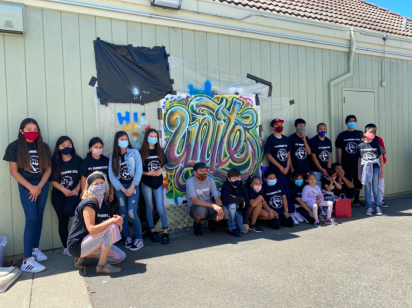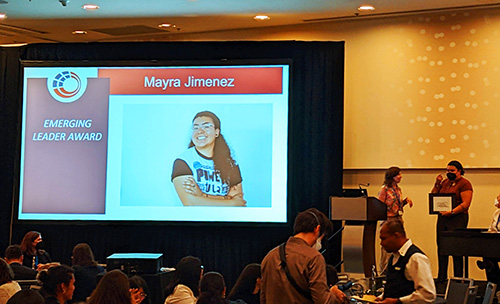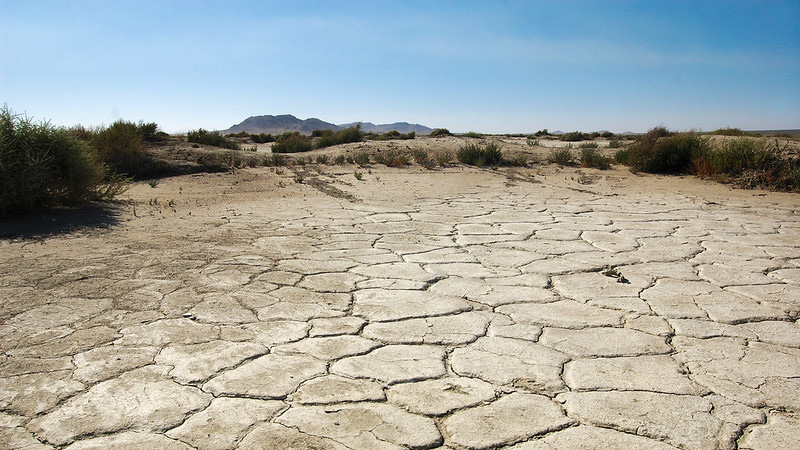Blog
Youth For Justice Has a Million Reasons to Stay in the Fight
- Details
- Created: Monday, January 23 2023 09:01
 Alcohol Justice’s Youth For Justice (YFJ) program has always strived to plant seeds of positive change in San Rafael’s Canal District. As the recipients of a new million-dollar grant, YFJ can run its roots deep, providing expansive programming for the youth of the community for years to come.
Alcohol Justice’s Youth For Justice (YFJ) program has always strived to plant seeds of positive change in San Rafael’s Canal District. As the recipients of a new million-dollar grant, YFJ can run its roots deep, providing expansive programming for the youth of the community for years to come.
The funding comes from Elevate Youth, a grantmaking project under the Sierra Foundation, which disburses prevention funds from California’s cannabis taxes. The money is dedicated to promoting youth leadership programs in the communities hardest hit by the war on drugs, notably low-income BIPOC communities. The Canal—where Alcohol Justice is located—is one of these districts, with 73% of residents identifying as Hispanic, and a median household income of $40,000 per year—only 40% that of San Rafael as a whole.
The funds go to support YFJ’s unceasing efforts to provide prevention education, community space, and leadership opportunities for the Canal’s youth. The program is based on a “Four-Pillar” model, developed by YFJ director Maite Durán. The pillars comprise Health and Healing, Nature Connection, Culture and History of Latino/Indigenous Peoples, and Community Organizing to Prevent Alcohol and Other Drug Harm.
 The ongoing programming includes exploring emotions and identity through art, cooking, gardening, and engagement with the natural environment of Marin, as well as mingas. Derived from an indigenous Kichwa word for a day of collective volunteer work, the mingas gather the YFJ staff and participants together to engage in community cleanups and beautifications. By removing trash, and particularly drug- and alcohol-related litter, the kids both develop pride in their neighborhood and reduce the normalization of substance use.
The ongoing programming includes exploring emotions and identity through art, cooking, gardening, and engagement with the natural environment of Marin, as well as mingas. Derived from an indigenous Kichwa word for a day of collective volunteer work, the mingas gather the YFJ staff and participants together to engage in community cleanups and beautifications. By removing trash, and particularly drug- and alcohol-related litter, the kids both develop pride in their neighborhood and reduce the normalization of substance use.
This positive energy can be used for more aggressive change as well. On multiple occasions, the kids who make up YFJ have organized to push back against harmful alcohol industry practices. The kids have assessed the sales environment of alcohol licensees in San Rafael, picketed stores that sell the most harmful products, and persuaded liquor stores in the community to agree to make the Canal an “alcopop-free zone.”
Alcohol Justice was one of 61 community and tribal organizations to receive funding from Sierra. The grant runs for the next three years.
READ MORE about youth-friendly stores in San Rafael.
READ MORE about the kids of YFJ taking to the streets.
AP19 Roundup: AJ and CAPA Take The Message National
- Details
- Created: Tuesday, October 18 2022 10:06
 The first disconcerting aspect of the U.S. Alcohol Policy Alliance's semiannual conference was not the sheer number of research, policymakers, and advocates. It was not the bleak but historical grandeur of its Washington, DC setting. No, it was the fact that the 2022 conference was labeled "Alcohol Policy 19," suggesting we had somehow time traveled.
The first disconcerting aspect of the U.S. Alcohol Policy Alliance's semiannual conference was not the sheer number of research, policymakers, and advocates. It was not the bleak but historical grandeur of its Washington, DC setting. No, it was the fact that the 2022 conference was labeled "Alcohol Policy 19," suggesting we had somehow time traveled.
In some ways, it felt appropriate, as Alcohol Justice and California Alcohol Policy Alliance (CAPA) staff met face-to-face (albeit while masked) with people who had only existed through Zoom screens for the past three years. In other ways, it felt odd: the entire tenor of alcohol policy had shifted amidst the enormous deregulatory changes pursued by alcohol industry during the COVID-19 lockdowns.
Howeverer the most startling--in a good way--aspect of AP19 was the surprise award given to CAPA Advocacy Manager Mayra Jiménez. Recognizing her tireless and, more importantly, effective work in organizing communities in Los Angeles and across California to protect public health and safety, the intended honor was nonetheless never shared with Jiménez herself until she was summoned to the stage during the Thursday luncheon to receive it.
In fact, organizers had to hunt her down. She was nowhere near the banquet hall, instead remaining in a presentation side-room, speaking with participants in her "Popular Education for Policy Change" workshop, sharing the CAPA organizing model with would-be advocates from across the country. In a perfect bit of irony, the reason why she earned the award was nearly the reason why she was not there to receive it.
Jiménez was also heavily involved in the pre-conference Advocacy Institute, while Research Director Carson Benowitz-Fredericks reported on both local San Rafael campaigns to reform retail environments, and statewide concerns over the enshrinement of temporary alcohol control "regulatory relief" into law. Because nothing is quite as upsetting as the continued creep of alcohol industry power and the harms that come with it.
READ MORE about the Alcohol Justice-affiliated presentations at AP19.
READ MORE live Tweets from AP19.
How Dry I Am: Big Alcohol Mines Mexico for Water
- Details
- Created: Tuesday, October 18 2022 09:35
The repeated prosection/persecution of Mexicali Resiste activists
 was not enough to get the Mexican federal government to step in. The daylight assassination of an advocate for indigenous farmers' water access in Tecate was not enough to get the Mexican federa government to step in. Only in the face of a crippling water crisis that has many households in Northern Mexico reliant on water tankers has Mexican President Andrés Manuel López Obrador called for a moratorium on brewery operations in the parched region.
was not enough to get the Mexican federal government to step in. The daylight assassination of an advocate for indigenous farmers' water access in Tecate was not enough to get the Mexican federa government to step in. Only in the face of a crippling water crisis that has many households in Northern Mexico reliant on water tankers has Mexican President Andrés Manuel López Obrador called for a moratorium on brewery operations in the parched region.The dire state has been caused by a confluence of historical and environmental factors. Anthropogenic climate change has created drought conditions in western North America that have not been seen in over a millenium. Absent regular rainfall, the entire region relies on two sources: riverflow, and groundwater. Meanwhile, northern Mexico's access to watersheds is blocked upstream by treaties entitling U.S. states to the lion's share of cross-border flows, particularly of the Colorado River which is nonetheless vitally important to Mexcali and Tecate. Yet it is impossible to truly characterize the crisis afflicting northern Mexico without looking at the actions of industries in the region--of which the breweries occupy a position somewhere between emblematic and epidemic.
U.S. consumers have a taste for imported beer. According to the beer institute, one out of every six beers consumed in the U.S. is imported. Of those imports, an overwhelming 80% comes from Mexico. There are policy reasons for this discrepancy: antitrust and consumer laws require that beers labeled as Mexican be actually produced in Mexico. There are economic ones as well: the lower wage standards across the border make production mere miles from the United States a cost-effective strategy. (This plays out in the strange mirror that is Calexico, in California, and Mexicali, in Baja California. The two cities are essentially a single metropolis cut through by the border. Yet because all the manufacturing occurs in Mexico, Mexicali's population is at least 20 times larger than its sister's.)
In a condition when faucets cough dust, it is nothing short of aggressive resource extraction, with the U.S. letting some trickles flow towards the Gulf of California before intercepting it and shipping it right back north.
López Obrador's intervention may mean a slight relief for the dessicated northern Mexican states. (It also, at this writing, still just words.) But it may also simply mean moving the site of extraction. After years of tenacious opposition by Mexicali Resiste and other local water defense activists, Constellation Brands supposedly shuttered their border brewery and relocated to Veracruz to reduce water impacts. This move appears to address border concerns, but only because news of Veracruz's own water crisis is harder to come by.
As this water crisis deepens and western North America becomes forced to accept the possibility of new, arid norms, it becomes impossible to treat water as an endless boon, and ignore the complicity of industries like alcohol producers in perpetuating crisis while pursuing profits. The United States can no longer afford to dry up Mexican wells just to wet consumer palates.
READ MORE about the struggles and triumphs of Mexicali Resiste.
Image by tschundler via Flickr, used under Creative Commons license.
More Articles ...
Subcategories
Help us hold Big Alcohol accountable for the harm its products cause.
| GET ACTION ALERTS AND eNEWS |
STAY CONNECTED    |
CONTACT US 24 Belvedere St. San Rafael, CA 94901 415-456-5692 |
SUPPORT US Terms of Service & Privacy Policy |


